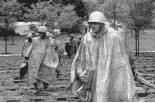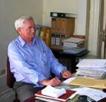by Henry E. Mattox
Many Americans hoped and even expected that American military withdrawal from Iraq would be well underway by now, but instead we had the “surge.” Looking back to the time of U.S. emergence as a world power, this essay finds that far from being unusual, prolonged American military presence in trouble spots abroad has been “a staple of Washington’s strategic outlook through most of the twentieth century and into the twenty-first.” —Ed.
Histories make men wise . . .
Francis Bacon, Essays. Of Studies, 1597
How long should America’s direct involvement in Iraq continue? This observer of the international scene wonders if past U.S. policy decisions might shed light on one of the factors bearing on the Iraq question. As discussed by Frank Hoffman, for example, in an article republished in this journal slightly over a year ago,* and as indicated in the Iraq Study Group Report issued, it happens, soon thereafter, the expectation at that time was for most, if not necessarily all, U.S. combat brigades to be withdrawn during the first quarter of 2008. Now, that is. Such has not been the case; indeed, the “surge strategy” of mid-2007 resulted in more, not fewer, troops being sent to Iraq. For the most part, those additional troops remain.
Close to five years have passed since America invaded that benighted country. President Bush declared the war won less than two months after the invasion. The fighting and dying and destruction have continued, however, although recently on a reduced scale and wholly in the form of anti-insurgency, pacification action. American troops at present are expected to remain for anything from a few months into 2009, to the duration of several upcoming U.S. presidential administrations, to, in one imprecise formulation, possibly a century down the road.
Consulting segments of the historical record as a possible indicator, we can look to America’s experiences in more or less analogous situations over the past century. Perhaps the conclusion to be reached is not what might be expected if one hopes fervently that the United States withdraws militarily from Iraq soon, turning over responsibility for security to the Iraqis (see conclusion below). America at one time after the First World War bore the label of isolationist, but more recently, over a long span of years, has sent and kept military forces abroad for extended periods of time. This perhaps counterintuitive statement bears examination.
 Looking initially all the way back to 1898, we begin with the Spanish-American War, when the United States entered the world scene as a major power, trouncing Spain in a brief conflict and taking possession of the Philippines and certain Caribbean islands, while foreswearing the acquisition of Cuba. There ensued four years of fierce fighting with Filipino insurgents, followed by occupation, including a period after 1934 when Washington declared the Islands a U.S. commonwealth. Not counting more than three years’ control by Japan during World War II, America occupied the Philippines until 1946, a total of some four and a half decades.
Looking initially all the way back to 1898, we begin with the Spanish-American War, when the United States entered the world scene as a major power, trouncing Spain in a brief conflict and taking possession of the Philippines and certain Caribbean islands, while foreswearing the acquisition of Cuba. There ensued four years of fierce fighting with Filipino insurgents, followed by occupation, including a period after 1934 when Washington declared the Islands a U.S. commonwealth. Not counting more than three years’ control by Japan during World War II, America occupied the Philippines until 1946, a total of some four and a half decades.
A second illustrative example: Following immediately upon the Second World War, the Cold War spawned Washington’s policy of “Containment” as a means to counter communist expansion, bringing about the formation of the Atlantic Alliance and NATO. U.S. policymakers installed a far-flung military presence overseas, primarily in Western Europe and the Far East. The period involved, up through the collapse and disappearance of the Soviet Union at the end of 1991, runs to about forty-six years. Largely because of the rise of other threats to world peace, namely those emanating from radical Islam, U.S. forces remain to this day in many of those same areas, plus importantly, the Middle East.
In this framework of Cold War Containment, America fought two major wars, albeit limited geographically in scope, in the second half of the twentieth century — in Korea and in Vietnam.
 U.S. troops had been stationed in the southern half of divided Korea since that republic’s formation in 1948. A 1950 invasion from the communist north, backed by the Soviets and newly emerging Communist Chinese, brought American and UN intervention. After heavy fighting, a truce in 1953 reestablished the demarcation line roughly where it had been originally. Containment in Korea had succeeded at a cost of more than 160,000 U.S. service personnel killed or wounded and $50 billion spent. Washington maintains an armed forces presence in South Korea to this day, 60 years after their introduction.
U.S. troops had been stationed in the southern half of divided Korea since that republic’s formation in 1948. A 1950 invasion from the communist north, backed by the Soviets and newly emerging Communist Chinese, brought American and UN intervention. After heavy fighting, a truce in 1953 reestablished the demarcation line roughly where it had been originally. Containment in Korea had succeeded at a cost of more than 160,000 U.S. service personnel killed or wounded and $50 billion spent. Washington maintains an armed forces presence in South Korea to this day, 60 years after their introduction.
 The Vietnam War tested Containment severely. North and South Vietnam, formed after the French were ejected in 1954, fought constantly until 1975. Over a period of eight years, from the administration of Eisenhower, when American advisers were first sent, to that of Nixon, U.S. aid sustained, and American military forces defended, the Saigon government. By early 1969, well over 500,000 American troops were stationed in the South. It was all to no avail: Containment utterly failed in Vietnam, at a cost of over 400,000 U. S. military personnel killed or wounded and monetary expenditures in excess of $140 billion. American forces were withdrawn by 1973, U.S. aid was curtailed, and the South collapsed, to be incorporated by the North in 1975.
The Vietnam War tested Containment severely. North and South Vietnam, formed after the French were ejected in 1954, fought constantly until 1975. Over a period of eight years, from the administration of Eisenhower, when American advisers were first sent, to that of Nixon, U.S. aid sustained, and American military forces defended, the Saigon government. By early 1969, well over 500,000 American troops were stationed in the South. It was all to no avail: Containment utterly failed in Vietnam, at a cost of over 400,000 U. S. military personnel killed or wounded and monetary expenditures in excess of $140 billion. American forces were withdrawn by 1973, U.S. aid was curtailed, and the South collapsed, to be incorporated by the North in 1975.
As already noted, other threats to world peace have replaced that of communism. Turmoil in the Middle East and the threat of Islamic terrorism, especially after 9/11, gave rise to an added U.S. military presence in the area even before the current Iraq War.
 The Gulf War of early 1991 saw swift action by U.S. and coalition forces against Iraq to negate Saddam’s invasion of oil-rich Kuwait. It was the American military’s finest hour since World War II, a markedly decisive and quick victory. Losses were held to some 800 Americans killed or wounded; coalition nations reimbursed Washington for most of the $60 billion cost. By April 1991, a formal cease-fire came into play and U.S. troops quickly departed. Washington left no occupation forces but strengthened the U.S. presence in the region.
The Gulf War of early 1991 saw swift action by U.S. and coalition forces against Iraq to negate Saddam’s invasion of oil-rich Kuwait. It was the American military’s finest hour since World War II, a markedly decisive and quick victory. Losses were held to some 800 Americans killed or wounded; coalition nations reimbursed Washington for most of the $60 billion cost. By April 1991, a formal cease-fire came into play and U.S. troops quickly departed. Washington left no occupation forces but strengthened the U.S. presence in the region.
The final instance of hostilities and occupation to be cited here is the focus of the current comments: Again Iraq. In March 2003, Washington launched the Iraq War. On May 1, President Bush was able to declare major combat ended. The occupation phase of the action against suddenly increasing insurgency and sectarian violence began — and continues to this day (February 2008), almost five years later. Approximately 160,000 American troops remain there. Almost 4,000 U.S. troops have been killed; untold billions of dollars have been spent, most of it on the continuing pacification phase. Uncertainty is wide-spread in Washington and in the American body politic about how much longer America will be tied down to a costly military commitment in that distant land.
We note here a point possibly not anticipated in this account: Despite the American public’s suspicions on the justification for the war, dissatisfaction with Washington’s conduct of the war, and the lack of a plan for withdrawing U.S. forces, and notwithstanding most people’s general unhappiness with the Iraq War and how it continues to drag on — still U.S. forces have not been involved in Iraq nearly as long as in other instances during the fairly recent past.
As recounted above, Washington has dispatched and stationed troops abroad following a number of other clashes or threats to national security. The historical record of major U.S. military ventures abroad that resulted in scant engagement after the conclusion of hostilities reveals few examples. Keeping U.S. forces at key points abroad primarily to meet possible dangers has been a staple of Washington’s strategic outlook through most of the twentieth century and into the twenty-first. As devoutly as the withdrawal of American forces in Iraq, and soon, is to be wished, therefore, certainly Washington in this instance, the Iraq War, is plowing no new foreign policy ground. For different reasons, under different circumstances, it has all been done before.![]()
* www.unc.edu./depts/diplomat/item/2007/0103/hoff/hoffman_longwar.html . Republished by permission of FPRI.

Henry Mattox, the journal’s contributing editor, was a Foreign Service officer from 1957 to 1980, serving in France, Portugal, Brazil, Nepal, Haiti, England, and Egypt, in addition to a couple of Washington assignments. After retiring from the Service to North Carolina, he entered academe, studying, writing, and teaching part time, a course of action that led to a Ph.D. in U.S. diplomatic history from the University of North Carolina at Chapel Hill in 1986. He was editor of American Diplomacy from its founding in 1996 until July, 2007.
